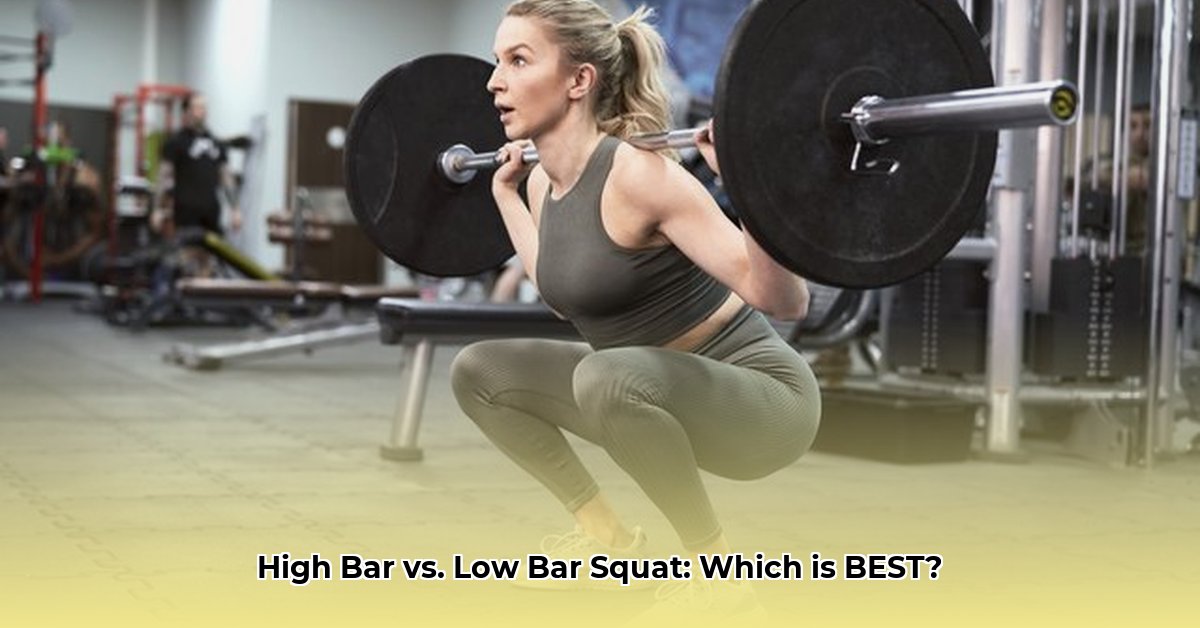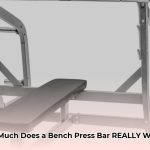Ever wondered why there are different ways to do squats? It’s not just about looking fancy; the way you hold the bar on your back completely changes which muscles work hardest and how much weight you can lift. This guide breaks down the high-bar and low-bar squats, showing you how to do each one correctly and explaining which one is best for *your* goals – whether you’re aiming for massive strength, serious muscle growth, or just want to get better at squatting. We’ll clear up the confusion so you can squat smarter, not harder, and avoid injuries along the way. Get ready to unlock your squat potential!
High Bar vs Low Bar Squat: Finding Your Perfect Squat
Picking between a high bar and low bar squat can be confusing. They both build strength, but in different ways. This guide breaks it all down so you can choose the right squat for you, based on your anatomy and goals. Discover key differences in muscle activation and find the best squat for your fitness objectives.
Understanding the Basic Differences
The main difference boils down to where you place the barbell on your back. In a high bar squat, the bar sits high on your upper back, across your trapezius muscles (upper back, near your neck). This positioning typically encourages a more upright torso. A low bar squat, on the other hand, places the bar lower, resting on your rear deltoids (those shoulder muscles at the back). This encourages a more forward lean. This seemingly tiny change completely alters how your muscles work and feels very different. Bar placement can significantly change muscle engagement during squats.
Mastering the Moves: A Step-by-Step Guide
Let’s get into the nitty-gritty of how to perform each squat correctly. Remember, proper form is key to avoid injury and get the most out of your workout. Achieving proper form minimizes injury risk and maximizes workout effectiveness.
High Bar Squat: A Step-by-Step Guide
- Set Up: Load the barbell and position it comfortably across your upper trapezius muscles (upper back). Your feet should be about shoulder-width apart, with your toes slightly pointed outward (around 15-30 degrees). Stand tall, engaging your core. This core engagement is critical for stability. Grip the bar slightly wider than shoulder-width apart.
- Going Down: Initiate the squat by pushing your hips back, as if you’re sitting in a chair. Keep your back as straight as possible (a slight natural arch is okay, but avoid rounding). Lower yourself until your thighs are parallel to the ground, or even slightly below, maintaining that upright posture. Think about keeping your chest up and your eyes focused forward to help maintain proper spinal alignment.
- Coming Up: Powerfully drive upward through your heels – imagine pushing the floor away from you. Extend both your hips and your knees to return to your starting position. Maintain control throughout the movement, avoiding any sudden locking of the knees at the top. Re-brace your core before beginning the next repetition.
Low Bar Squat: A Step-by-Step Guide
- Set Up: Load the barbell and position it lower across your rear deltoids (those shoulder muscles nearer your back). Your feet should be slightly wider than shoulder-width apart, with your toes pointed outward a bit more than in the high bar squat (around 30-45 degrees). Again, engage your core for stability. Grip the bar wider than you would for a high bar squat; experiment to find a comfortable and secure grip. Focus on squeezing your shoulder blades together to create a “shelf” for the bar to rest on.
- Going Down: Initiate the movement by pushing your hips back, bending your knees slightly as you go. Maintain a more significant forward lean than in the high bar squat; your back should still be relatively straight, avoiding rounding. Descend until your thighs are parallel to the ground. Maintain a tight upper back throughout the movement to keep the bar secure.
- Coming Up: Explosively drive upward through your heels, fully extending your hips and knees to return to the starting position. Control the movement throughout, paying close attention to your form. Focus on maintaining the forward lean and driving your hips up and forward.
Muscle Teamwork: Who’s Doing What?
The high bar and low bar squats don’t just feel different; they activate different muscles more prominently. Understanding muscle activation can help tailor your workout to meet your specific goals.
High Bar Squat: This squat primarily targets your quadriceps (the front of your thighs), but also significantly engages your glutes (butt muscles) and hamstrings (back of your thighs). It also requires decent hip and ankle mobility to perform correctly. Additionally, your core muscles work hard to maintain an upright torso.
Low Bar Squat: This variation emphasizes your posterior chain – primarily your glutes, hamstrings, and lower back muscles (erector spinae) – allowing you to potentially lift heavier weights. It tends to place less demand on your ankles but requires good hip mobility and lower back strength. The core is still heavily involved, but with a greater emphasis on resisting spinal flexion due to the forward lean.
Which Squat is Best for You?
The “better” squat is subjective and depends entirely on your individual goals, physical abilities, and even your individual anatomy. Personal goals alongside abilities determine which squat is ideal for you.
| Squat Type | Advantages | Disadvantages | Ideal For |
|---|---|---|---|
| High Bar Squat | Great for quad development, improves overall leg strength, better for Olympic lifting styles, promotes more upright posture, may be easier to learn for beginners | May limit how much weight you can lift, demands more mobility at your ankles and hips | Olympic weightlifters, building quadriceps strength, athletes prioritizing upright posture, those with limited lower back strength |
| Low Bar Squat | Allows for heavier weightlifting, excellent for building strength in your glutes and hamstrings, suitable for powerlifters, often easier on the ankles, can be beneficial for those with knee pain (when performed correctly) | Can put more stress on your lower back, requires good strength in your lower back muscles, may be more challenging to learn proper form | Powerlifters, building posterior chain strength, individuals with limited ankle mobility, those seeking to maximize the weight they can lift |
Addressing Your Concerns
Many people have questions or concerns about squats. Let’s tackle some common ones. Addressing typical concerns ensures a safer workout experience.
- Ankle Mobility Issues: Tight ankles can hamper both squat variations. The high bar squat generally requires more ankle mobility. Work on improving your ankle mobility with dedicated stretches and exercises like ankle dorsiflexion stretches and calf raises.
- Back Pain: Back pain during squats almost always points to poor form. A rounded back is a common culprit. If you experience pain, reassess your technique, lighten the weight, and possibly seek guidance from a qualified professional who can assess your form. Strengthening your core and lower back muscles can also help.
- Knee Pain: Pre-existing knee problems? Consult a physical therapist or doctor before adding squats to your workout. They can help determine the cause of your knee pain and recommend appropriate exercises and modifications. The low bar squat, when performed with proper form, can sometimes be less stressful on the knees than the high bar squat, but this is not always the case.
- Shoulder Pain: Some people experience shoulder pain, particularly during the low bar squat, due to the increased shoulder external rotation and adduction required to hold the bar in place. If this is the case, work on improving your shoulder mobility with stretches and consider widening your grip on the bar.
Ultimately, the choice between these two squat variations comes down to personal preference and what works best for your body. Pay attention to how your body feels. Focus on mastering your form before increasing weight. There’s no single “right” squat; the right one is the one that helps you achieve your fitness goals safely and effectively. Enjoy the process and keep learning! Focusing on form can reduce injury risk significantly.
How to Choose Between High Bar and Low Bar Squats Based on Individual Anatomy
Key Takeaways:
- High-bar squats emphasize quadriceps activation, promoting upright posture and explosive power. They’re often better for beginners and those with good ankle mobility.
- Low-bar squats maximize glute and hamstring engagement, allowing for heavier weights and are favored by powerlifters. They can be a good option for those with longer femurs or limited ankle mobility.
- The best squat variation depends on your unique body structure, mobility, and training goals. There is no “one size fits all” approach.
- Consider your hip, ankle, and shoulder mobility when choosing a squat variation. Limited mobility in any of these areas can impact your ability to perform a squat safely and effectively. Consulting with a qualified coach or physical therapist can be beneficial in assessing your mobility and determining the best squat variation for you.
Understanding the Differences: High Bar vs. Low Bar
Think of high-bar and low-bar squats like two different paths up a mountain. Both lead to the summit (strength gains), but the route and the muscles used differ. The high-bar squat is your direct, steep ascent – a more upright position that favors your quads. The low-bar squat is a more gradual, winding path, emphasizing glutes and hamstrings, allowing for heavier loads. Understanding how to choose between high bar and low bar squats based on individual
- Doctor Work Life Balance: Proven Strategies for Physician Well-being - November 20, 2025
- Find Your Work-Life Harmony: Quotes for a Fulfilling Life - November 18, 2025
- CRNA Work-Life Balance: Strategies for a Healthier Lifestyle - November 16, 2025
















